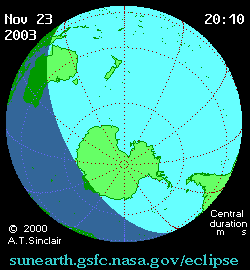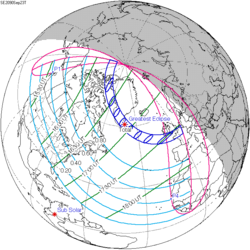Top Qs
Timeline
Chat
Perspective
Solar eclipse of November 23, 2003
Total eclipse From Wikipedia, the free encyclopedia
Remove ads
A total solar eclipse occurred at the Moon's descending node of orbit between Sunday, November 23 and Monday, November 24, 2003,[1][2] with a magnitude of 1.0379. A solar eclipse occurs when the Moon passes between Earth and the Sun, thereby totally or partly obscuring the image of the Sun for a viewer on Earth. A total solar eclipse occurs when the Moon's apparent diameter is larger than the Sun's, blocking all direct sunlight, turning day into darkness. Totality occurs in a narrow path across Earth's surface, with the partial solar eclipse visible over a surrounding region thousands of kilometres wide. Occurring about 25 minutes before perigee (on November 23, 2003, at 23:15 UTC), the Moon's apparent diameter was near its maximum.[3] Perigee did occur just past the greatest point of this eclipse.
For most solar eclipses the path of totality moves eastwards. In this case the path moved south and then west round Antarctica.
Totality was visible from a corridor in eastern Antarctica. A partial eclipse was visible for parts of Australia, New Zealand, Antarctica, southern Chile, and southern Argentina.
Remove ads
Observations
A Russian icebreaker departed from Port Elizabeth, South Africa carrying tourists to observe the eclipse near the Shackleton Ice Shelf and Novolazarevskaya Station, and then sailed to Hobart, Tasmania. About 100 people from 15 countries were on board, including Iranian amateur astronomer Babak Amin Tafreshi, NASA's Goddard Space Flight Center astrophysicist Fred Espenak, Williams College professor Jay Pasachoff. There are also about 200 scientists and tourists taking two commercial charter flights to observe it over Antarctica. This was the first time humans observed a total solar eclipse from Antarctica.[4][5][6]
Remove ads
Images

Eclipse timing
Places experiencing partial eclipse
Remove ads
Eclipse details
Summarize
Perspective
Shown below are two tables displaying details about this particular solar eclipse. The first table outlines times at which the Moon's penumbra or umbra attains the specific parameter, and the second table describes various other parameters pertaining to this eclipse.[7]
Remove ads
Eclipse season
This eclipse is part of an eclipse season, a period, roughly every six months, when eclipses occur. Only two (or occasionally three) eclipse seasons occur each year, and each season lasts about 35 days and repeats just short of six months (173 days) later; thus two full eclipse seasons always occur each year. Either two or three eclipses happen each eclipse season. In the sequence below, each eclipse is separated by a fortnight.
Remove ads
Related eclipses
Eclipses in 2003
- A total lunar eclipse on May 16.
- An annular solar eclipse on May 31.
- A total lunar eclipse on November 9.
- A total solar eclipse on November 23.
Metonic
- Preceded by: Solar eclipse of February 5, 2000
- Followed by: Solar eclipse of September 11, 2007
Tzolkinex
- Preceded by: Solar eclipse of October 12, 1996
- Followed by: Solar eclipse of January 4, 2011
Half-Saros
- Preceded by: Lunar eclipse of November 18, 1994
- Followed by: Lunar eclipse of November 28, 2012
Tritos
- Preceded by: Solar eclipse of December 24, 1992
- Followed by: Solar eclipse of October 23, 2014
Solar Saros 152
- Preceded by: Solar eclipse of November 12, 1985
- Followed by: Solar eclipse of December 4, 2021
Inex
- Preceded by: Solar eclipse of December 13, 1974
- Followed by: Solar eclipse of November 3, 2032
Triad
- Preceded by: Solar eclipse of January 23, 1917
- Followed by: Solar eclipse of September 23, 2090
Solar eclipses of 2000–2003
This eclipse is a member of a semester series. An eclipse in a semester series of solar eclipses repeats approximately every 177 days and 4 hours (a semester) at alternating nodes of the Moon's orbit.[8]
The partial solar eclipses on February 5, 2000 and July 31, 2000 occur in the previous lunar year eclipse set.
Saros 152
This eclipse is a part of Saros series 152, repeating every 18 years, 11 days, and containing 70 events. The series started with a partial solar eclipse on July 26, 1805. It contains total eclipses from November 2, 1967 through September 14, 2490; hybrid eclipses from September 26, 2508 through October 17, 2544; and annular eclipses from October 29, 2562 through June 16, 2941. The series ends at member 70 as a partial eclipse on August 20, 3049. Its eclipses are tabulated in three columns; every third eclipse in the same column is one exeligmos apart, so they all cast shadows over approximately the same parts of the Earth.
The longest duration of totality will be produced by member 30 at 5 minutes, 16 seconds on June 9, 2328, and the longest duration of annularity will be produced by member 53 at 5 minutes, 20 seconds on February 16, 2743. All eclipses in this series occur at the Moon’s descending node of orbit.[9]
Metonic series
The metonic series repeats eclipses every 19 years (6939.69 days), lasting about 5 cycles. Eclipses occur in nearly the same calendar date. In addition, the octon subseries repeats 1/5 of that or every 3.8 years (1387.94 days). All eclipses in this table occur at the Moon's descending node.
Tritos series
This eclipse is a part of a tritos cycle, repeating at alternating nodes every 135 synodic months (≈ 3986.63 days, or 11 years minus 1 month). Their appearance and longitude are irregular due to a lack of synchronization with the anomalistic month (period of perigee), but groupings of 3 tritos cycles (≈ 33 years minus 3 months) come close (≈ 434.044 anomalistic months), so eclipses are similar in these groupings.
The partial solar eclipses on November 16, 2134 (part of Saros 164) and October 16, 2145 (part of Saros 165) are also a part of this series but are not included in the table below.
Inex series
This eclipse is a part of the long period inex cycle, repeating at alternating nodes, every 358 synodic months (≈ 10,571.95 days, or 29 years minus 20 days). Their appearance and longitude are irregular due to a lack of synchronization with the anomalistic month (period of perigee). However, groupings of 3 inex cycles (≈ 87 years minus 2 months) comes close (≈ 1,151.02 anomalistic months), so eclipses are similar in these groupings.
Remove ads
Notes
- The times listed for this location occur on November 24, 2003, local time.
References
External links
Wikiwand - on
Seamless Wikipedia browsing. On steroids.
Remove ads


































































































